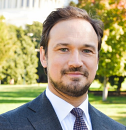Revisiting the USPTO’s Rulemaking Authority after
Cuozzo and City of Arlington
Taking place via WebEx on
Friday, September 10, 2021
2pm-4pm ET
Policy Workshop Hosted by the Amicus Committee of The Naples Roundtable
Confirmed speakers/panelists

Duke University School of Law

McKool Smith (former Acting General Counsel USPTO)

University of Houston Law Center

Texas A&M University School of Law
Moderator

Amicus Committee Chair, The Naples Roundtable
Questions to be debated
- After City of Arlington, will the USPTO’s interpretation of 35 U.S.C. § 2(b)(2)(A) be owed Chevron deference?
- After Cuozzo, will the Federal Circuit continue to interpret § 2(b)(2)(A) as being limited to “procedural”—as distinct from “substantive”—rules?
- How should § 2(b)(2)(A) be interpreted?
- What new rules might the Biden Administration offer to test the scope of § 2(b)(2)(A)?
Background
Congress has empowered the U.S. Patent & Trademark Office to “establish regulations, not inconsistent with law, which … shall govern the conduct of proceedings in the Office.” 35 U.S.C. § 2(b)(2)(A). The scope of this rulemaking authority has been hotly contested. For its part, the USPTO has taken the position that this statutory provision does not categorically limit the agency’s rulemaking authority to “procedural” (as distinct from “substantive”) rules and, further, that the agency’s interpretation of this provision is entitled to Chevron deference. The Federal Circuit rejected both these arguments in Tafas v. Doll (Fed. Cir. 2009), holding instead that no deference is owed to the USPTO’s interpretation of § 2(b)(2)(A), which the court held to contain a “procedural” limit on the USPTO’s rulemaking authority. Since then, the U.S. Supreme Court has issued two rulings that may call Tafas into question. First, in City of Arlington v. FCC (2013), the Supreme Court held that an agency’s interpretation of a statutory ambiguity that concerns the scope of its regulatory authority is entitled to Chevron deference. Second, in Cuozzo Speed Technologies v. Lee (2016), the Supreme Court noted, albeit in passing, that § 2(b)(2)(A) “does not clearly contain the [Federal] Circuit’s claimed limitation,” i.e., being “limited to procedural rules.” In light of these intervening Supreme Court decisions, the Naples Roundtable will examine and debate what impact, if any, these decisions have on the USPTO’s § 2(b)(2)(A) rulemaking authority post-Tafas.
Invitations are non-transferable
Registration is now closed.
